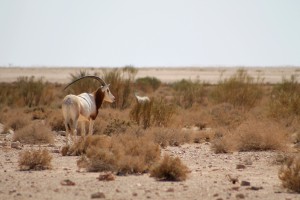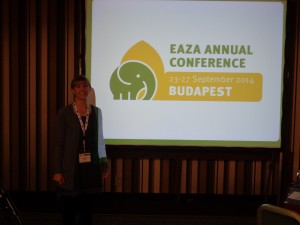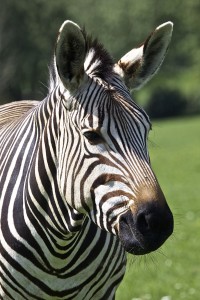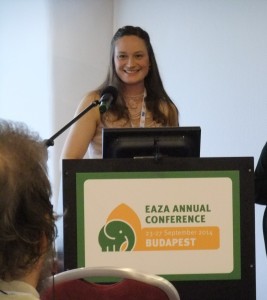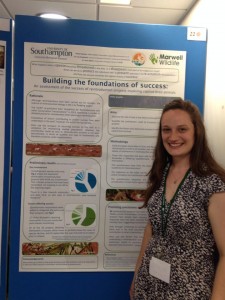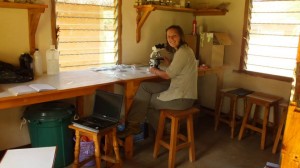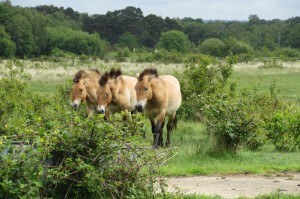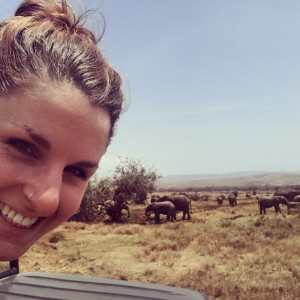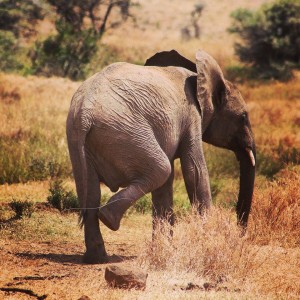The academic year has come to an end in the blink of an eye. It seems like yesterday that we all met for the first time, embarking on a new and incredible journey together; one that would test our resolve, expand our minds, and ultimately provide us with the skills and knowledge we need to enter into a career that we are passionate about. We have handed in our dissertations, returned our library books, reluctantly given back our camera traps and now want to take a moment to round up our research projects and say our goodbyes.
Robert Cooke
Project summary: My research project looked to understand the interrelationship between scimitar-horned oryx Oryx dammah and dorcas gazelle Gazella dorcas in the semi-arid ecosystem of central Tunisia. I used distance sampling to quantify the population sizes of both species and a generalised linear mixed-effect model (GLMM) to investigate how these species used the available habitat. This will inform managers of the best course of action for delivering viable populations of these threatened antelope.
Best experience: Coming face-to-face with a female golden jackal Canis aureus has got to be the highlight for me, an incredible, under-appreciated animal.
Key finding: I found that scimitar-horned oryx select for habitat with high floristic richness, which is an encouraging result. As it promotes the idea of biodiversity leading to more biodiversity, oryx require plant diversity and in turn their feeding habits lead to further plant diversity, leading to a fully functioning ecosystem.
The next step: I am now working part-time as a Research Technician in Transient Demography for the University of Southampton, together with an IUCN Antelope Specialist Group internship at Marwell Wildlife. This combination of three days at the University and two days at Marwell is the best of both worlds for me, and I can’t wait to get stuck-in to both of them!
Dani Free
Project summary: My research project focused on determining the relevance of social dynamics on the breeding success of captive Hartmann’s mountain zebra Equus zebra hartmannae. I analysed data regarding social dynamics collected from the Hartmann’s mountain zebra international studbook, in addition to that collated from questionnaires that were sent to members of the species’ EEP (European Endangered species Programme), using a Generalised Linear Mixed Model. The results from this research will help to influence the way this species is managed in captivity with the view to increasing reproductive success.
Key finding: The results from my project confirm that the social dynamics a species experiences in captivity can influence its breeding success. In the wild, both male and female Hartmann’s mountain zebra will leave their natal group prior to breeding age, and the results from this research suggest that it is important that this dispersal continues in captivity. The project also revealed the necessity for more detailed records to be maintained by zoo staff in order to enable detailed research to be conducted in the future.
Best experience: Presenting the findings from my project to the Equid Taxonomic Advisory Group at the European Association of Zoos and Aquaria Annual Conference in Budapest was one of my highlights. It felt incredible to be able to pass on the results that I had obtained to the people who would be able to use it to influence their management techniques and to be accepted as a serious researcher. The whole conference was a fantastic event that allowed for great connections to be made with important people in the areas in which I want to direct my career.
The next step: Since finishing the course I have obtained the new and exciting position of Science Officer at Marwell Wildlife that will allow me to develop my skills and knowledge concerning research, animal behaviour and welfare, as well as learn new skills such as lecturing to undergraduates.
Rachel Gardner
Project summary: My research project looked into the project management factors that are contributing to the level of success of reintroduction projects involving captive-bred animals. It also set out to quantify EAZA (European Association of Zoos and Aquaria) institution involvement in reintroduction projects. All data were collected via a questionnaire sent to EAZA members.
Key finding: I have found that the outcome of reintroduction projects is greatly influenced by a number of the decisions practitioners are making and this indicates that success really can be optimised by the approach taken to planning, implementing and following-up reintroductions; success is not purely due to biological factors beyond practitioner control. I have also found that EAZA institution involvement in reintroduction projects is far greater than previously formally reported.
Best experience: I had the fantastic opportunity to present the preliminary results of this research in September at EAZA’s Annual Conference in Budapest, and report back to the institutions who had provided me with the data for my research.
The next step: I am now very keen to enhance my field skills and am searching for job opportunities that would allow me to do this. I would very much like to become involved in the practical side of a reintroduction project in the future, in order to put the principles that I have spent such a long time looking into, into practice. I have had the most incredible experience over the last 12 months and am very proud to have been part of the inaugural year of the MRes Wildlife Conservation. From our field course in Kenya, to helping look after Marwell’s sand lizards and conducting a behavioural study on the male Amur tiger, to undertaking a piece of independent research on a topic that is drawing wide debate in the field of wildlife conservation – this course has provided me with the most invaluable and comprehensive skill-set to take forward.
Laura Pratt
Project summary: For my project I looked into the decline of the Grevy’s zebra on Lewa Wildlife Conservancy, and more specifically into the effect of the lion population on this species.
Key finding: The results of my project showed which species were important in the lion diet and which species were being selected for on Lewa. An impact on the recruitment, through predation on foals and pregnant females, was found for some of the species. I also studied the behaviour of the Grevy’s zebra and found that their vigilance behaviour was not affected by the presence of lions.
Best experience: I was privileged to be able to conduct my field research out in Kenya, spending a total of 10 weeks on the conservancy. This was filled with many incredible sightings of wildlife and adventures in the field with the fantastic Lewa research department. One of the most rewarding experiences was showing my field techniques to one of the research staff which enabled him to use these techniques in his work after I left.
The next step: I am heading back out to Kenya very shortly to assist on the MRes field course for the new students and to work with Dr Zeke Davidson (Marwell’s Conservation Biologist, based in Kenya). I am looking forward to the opportunity to use everything I have learnt this year in this role.
Eleanor Rendells
Project summary: My project was looking at the roles of conservation grazing animals and worming regimes in determining soil invertebrate communities on a lowland heath system. This involved putting various treatment types down on the soil, collecting soil cores and identifying the thousands (literally) of invertebrates found in those cores!
Key finding: The most striking result is that invertebrate abundance was higher in areas treated with cattle dung than in those treated with horse dung and that abundance of invertebrates was lower in areas treated with dung from animals given anti-parasitic medications than in areas with dung from animals not treated with the medication. This suggests livestock used for conservation grazing should continue without the anti-parasitic medications until further research has been conducted.
Best experience: My career aim is to work in UK habitat management and native species conservation, so by far the best element of my project was getting to work on a heathland and learn more about its characteristics and management practices. Come rain or shine, and I had a lot of both, Eelmoor Marsh (a SSSI and one of Marwell Wildlife’s UK sites) is beautiful and being able to contribute research towards its management is a real privilege!
The next step: Since finishing the project, I’ve been looking for jobs in the UK to work on habitat management and have recently been offered contract work with the conservation department at Marwell Wildlife! This means I can continue to work up at Eelmoor, alongside Marwell’s other UK sites and I’ll also have the chance to get more involved with their sand lizard breeding program. This work is exactly in the field I would like a career in so will be invaluable experience for the future!
Natalie Winmill
Project summary: My research project was based at Lewa Wildlife Conservancy in Kenya, where I spent two and a half months. I evaluated the Mount Kenya Elephant Corridor as a connection for elephants between the Laikipia region and Mount Kenya. The methods I used consisted of camera trapping the corridor and identifying elephants that were captured using it. In addition, I interviewed people involved with the corridor in order to understand their perspective of how successful the corridor has been.
Key finding: My project write up is due at the end of November; therefore I currently do not have any specific results to share. Even so, it appears that the corridor is seen as a massive success by the people involved and affected by it: it has provided the local community with a health clinic and reduced crop raiding by elephants.
Best experience: The most invaluable experience I gained from going to Kenya was setting up and running my own research project. This included organising data collection with vehicles and other organisations, contacting people to interview and creating a methodology. The experience allowed me to stand on my own two feet and gave me the confidence to make key decisions for my project. Another great aspect was having the opportunity to talk to lots of different people involved with conservation and elephants. This was particularly important to me as I have been offered an internship with one of these contacts where I will help to monitor elephants and analyse an extensive dataset that has been obtained over a ten year period during research with the Lewa elephants.
The next step: The MRes course has been an invaluable stepping stone in my wildlife conservation career. I have made great friends and contacts, and have gained a huge amount of knowledge and experience as well as leading me to the next step in my career.
Never doubt that a small group of thoughtful, committed citizens can change the world; indeed, it’s the only thing that ever has.”
Margaret Mead
Posted By : dvf1e13

